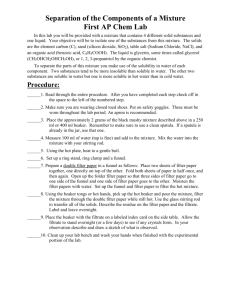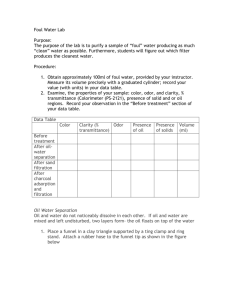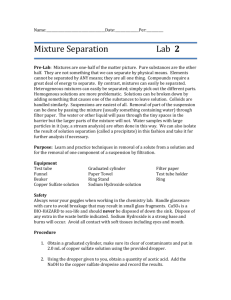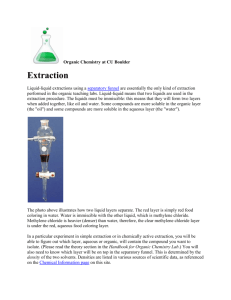three separation techniques
advertisement
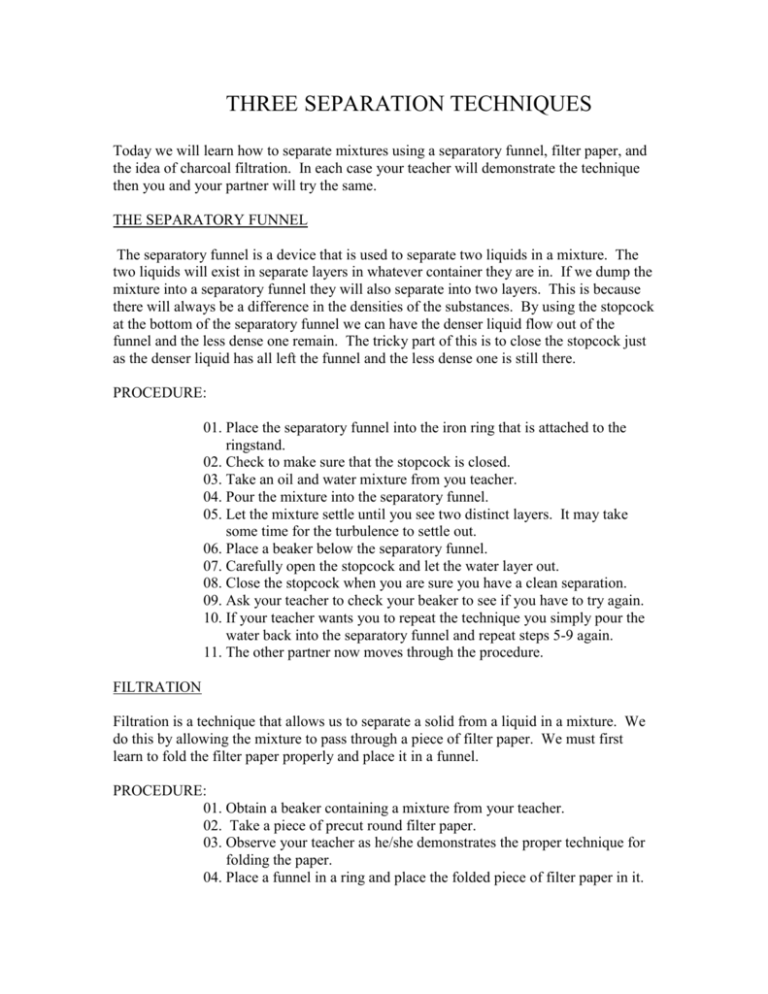
THREE SEPARATION TECHNIQUES Today we will learn how to separate mixtures using a separatory funnel, filter paper, and the idea of charcoal filtration. In each case your teacher will demonstrate the technique then you and your partner will try the same. THE SEPARATORY FUNNEL The separatory funnel is a device that is used to separate two liquids in a mixture. The two liquids will exist in separate layers in whatever container they are in. If we dump the mixture into a separatory funnel they will also separate into two layers. This is because there will always be a difference in the densities of the substances. By using the stopcock at the bottom of the separatory funnel we can have the denser liquid flow out of the funnel and the less dense one remain. The tricky part of this is to close the stopcock just as the denser liquid has all left the funnel and the less dense one is still there. PROCEDURE: 01. Place the separatory funnel into the iron ring that is attached to the ringstand. 02. Check to make sure that the stopcock is closed. 03. Take an oil and water mixture from you teacher. 04. Pour the mixture into the separatory funnel. 05. Let the mixture settle until you see two distinct layers. It may take some time for the turbulence to settle out. 06. Place a beaker below the separatory funnel. 07. Carefully open the stopcock and let the water layer out. 08. Close the stopcock when you are sure you have a clean separation. 09. Ask your teacher to check your beaker to see if you have to try again. 10. If your teacher wants you to repeat the technique you simply pour the water back into the separatory funnel and repeat steps 5-9 again. 11. The other partner now moves through the procedure. FILTRATION Filtration is a technique that allows us to separate a solid from a liquid in a mixture. We do this by allowing the mixture to pass through a piece of filter paper. We must first learn to fold the filter paper properly and place it in a funnel. PROCEDURE: 01. Obtain a beaker containing a mixture from your teacher. 02. Take a piece of precut round filter paper. 03. Observe your teacher as he/she demonstrates the proper technique for folding the paper. 04. Place a funnel in a ring and place the folded piece of filter paper in it. 05. Wet the filter paper slightly to allow it to adhere to the funnel. 06. Place a beaker under the funnel. 07. Pour some of the mixture into the funnel. Make sure that you do not allow the liquid to come any closer than one centimeter from the top of the filter paper. (Your teacher will explain the phenomenon called capillary action.) 08. Allow the mixture to pass through the filter paper. 09. When the mixture is almost through the funnel refill it again. Remember not to let the liquid get closer than a centimeter from the top. 10. You should see a clear liquid flowing into the beaker. 11. Clean all the solid from the beaker using a wash bottle (as demonstrated by your teacher.) 12. When all the mixture has passed through the funnel the job is finished. 13. If the liquid in the beaker is cloudy you have allowed some of the solid in the mixture to get around the filter paper and you will have to filter that liquid again. 14. Have your teacher look at your beaker to determine if you have to filter again. CHARCOAL ADSORPTION This is a technique in which we use the adsorptive properties of charcoal. Charcoal is very finely ground carbon that has a wonderful ability to adsorb some substances, especially colored ones. Many of the products you eat and use, as cosmetics are charcoal filtered as part of their manufacturing process. Before we use the charcoal your teacher will mix it with a bit of water. This is because the dry charcoal is very dusty and is easily inhaled which will not harm you but it can cause you to cough. Let’s see how this wonderful stuff works. PROCEDURE: 01. Your teacher will give you a beaker with some of the mixture that is to be separated in it. 02. Add two spoonfuls of the charcoal slurry (what is a slurry?) to the beaker. 03. Stir the mixture until you see the color of the liquid disappear. 04. Set up a filtration apparatus as you did in the previous part of this exercise. 05. Pour the charcoal and mixture through the funnel being careful not to pour in too much. 06. You should collect a clear liquid in the beaker. If you do not, you have to repeat the charcoal adsorption process again. 07. Have your teacher check to see if you need to go through the process again. Name Section Date ________________ ________________ ________________ SEPARATION TECHNIQUES HOMEWORK Fill in the blank with one of the following terms to indicate the procedure needed to achieve the separation (SEPARATORY FUNNEL, FILTRATION, AND CHARCOAL ABSORPTION) 01. ____________________ Remove sand from your Pepsi. 02. ____________________ Separate the oil from the vinegar in salad dressing. 03. ____________________ Take the color out of ginger ale. 04. ____________________ Make milk look like water. 05. ____________________ Remove the coffee grounds from your drink. 06. ____________________ Separate used toothpaste from saliva. 07. ____________________ Separate motor oil from water. 08. ____________________ Separate olive oil from water. 09. ____________________ Make orange juice look like water. 10. ____________________ Canola oil spilled into your grape juice. 11. ____________________ Get the chocolate bits out of your hot chocolate. 12. ____________________ You find motor oil in your Perrier. 13. ____________________ You want to make tomato juice look like lemonade. 14. ____________________ There are little stones in your Evian Water. 15. ____________________ You find olive oil in your spaghetti water. 16. ____________________ Make clear Coca-Cola. 17. ____________________ Make your Malta a little lighter in color. 18. ____________________ Have some Ovaltine that is not grainy. 19. ____________________ You find corn oil in your shampoo. 20. ____________________ Someone put liquid magarine in your Starbucks latte. 21. ____________________ Get the sand out of your lemonade. 22. ____________________ Get the lumps out of your powdered drink beverage. 23. ____________________ Make root beer look like lemon juice. 24. ____________________ Get the dirt out of your hand lotion. 25. ____________________ Take the seeds out of watermelon juice.



